

Çılgın Roma İmparatoru Caligula’nın Yaptığı 10 İlginç Şey. Gaius Julius Caesar Augustus Germanicus yani takma adıyla Caligula, kısaca deli olarak tanımlanabilecek olsa da, bu deliliğinin altı onca acımasız ve tuhaf örnekle doldurulabilir.
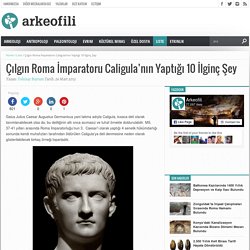
MS. 37-41 yılları arasında Roma İmparatorluğu’nun 3. Caesar’i olarak yaptığı 4 senelik hükümdarlığı sonunda kendi muhafızları tarafından öldürülen Caligula’ya deli denmesine neden olarak gösterilebilecek birkaç örneği toparladık. 1) Ergenliğinde üç kız kardeşiyle ensest ilişki yaşadı. 2) Astrologların söylediği “At üstünde Baiae körfezinin geçmeyenin imparator olma şansı yoktur” sözü üzerine İmparator olmasının duyurulmasının ardından Puteoli ve Baiae arasına sandallardan oluşan 3 mil uzunluğunda bir köprü yaptı ve Büyük İskender’in göğüslüğünü giyerek at üstünde körfezi geçti.
Kendini Roma tanrısı Neptün ile kıyaslayarak imparatorluğunu ilan etti. 3) Kelleşme kompleksi olan Caligula, ilk olarak yüksek bir yerden aşağıya doğru kendisine bakılmasını suç ilan etti. Didyma. Didyma: oracle of Apollo near Miletus.

Use two fingers to move the map Map Data Imagery ©2016 CNES / Astrium, DigitalGlobe Map DataImagery ©2016 CNES / Astrium, DigitalGlobe. Question about ancient depictions of hair : AskHistorians. In Ancient Mesopotamian statues, beards often appear to be ridged and segmented. Was this just the popular style of artistry or is this what their beards would actually look like? : AskHistorians. Aphrodisias – following hadrian photography. The beautiful ancient city of Aphrodisias, still partly excavated, is one of the most important archaeological sites of the late Hellenistic and Roman period in Turkey.
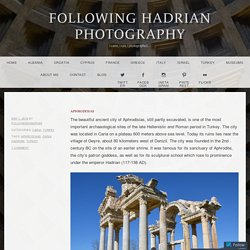
The city was located in Caria on a plateau 600 meters above sea level. Today its ruins lies near the village of Geyre, about 80 kilometers west of Denizli. The city was founded in the 2nd century BC on the site of an earlier shrine. It was famous for its sanctuary of Aphrodite, the city’s patron goddess, as well as for its sculptural school which rose to prominence under the emperor Hadrian (117-138 AD). Coordinates: 37° 35′ 30″ N, 27° 59′ 8″ E. My Hadrian 1900 project. No other Roman emperor travelled as much as Hadrian.
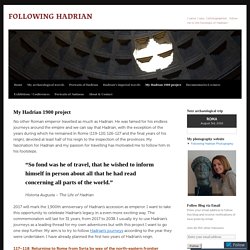
He was famed for his endless journeys around the empire and we can say that Hadrian, with the exception of the years during which he remained in Rome (119-120, 126-127 and the final years of his reign), devoted at least half of his reign to the inspection of the provinces. My fascination for Hadrian and my passion for travelling has motivated me to follow him in his footsteps. Historia Augusta – The Life of Hadrian 2017 will mark the 1,900th anniversary of Hadrian’s accession as emperor.
I want to take this opportunity to celebrate Hadrian’s legacy in a even more exciting way. Magnum incendium Romae (the Burning of Rome, 64 AD) – Nero the Arsonist on screen. This week marks the anniversary of the Great Fire of Rome, one of the worst disasters ever to hit the city of Rome.

This tragic event took place during the reign of Nero in 64 A.D. The fire began in the merchant area of the city near the Circus Maximus and rapidly spread through the dry, wooden structures of the Imperial City. According to Tacitus, the fire burned for six days and seven nights. Only four of the fourteen districts of Rome escaped the fire; three districts were completely destroyed and the other seven suffered serious damage. Colossal head of Nero belonging to a larger-than-life size statue,Glyptothek Museum, Munich© Carole Raddato. Varna Necropolis. The so-called Varna Necropolis (Bulgarian: Варненски некропол) (also Varna Cemetery) is a burial site from 4569–4340 BC in the western industrial zone of Varna (approximately half a kilometre from Lake Varna and 4 km from the city centre), internationally considered one of the key archaeological sites in world prehistory.
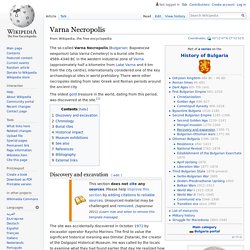
There were other necropoles dating from later Greek and Roman periods around the ancient city. Varna Necropolis. Archaeologist Identifies Long-lost Grave of Attalid Rulers, in Turkey - Haaretz - Israel News Haaretz.com. The long-lost burial site of the Attalid Dynasty, which ruled the city of Pergamon after Alexander the Great, may have been identified.

A vast mound first excavated almost 200 years ago in western Turkey is the spot, Prof. Felix Pirson thinks – and hopes to prove it soon using advanced technologies. Certainly, the monumental burial site at Yiğma Tepe, atop a hill by Pergamon (today Bergama) had to have been created to commemorate somebody vastly important. Xenophon. Xenophon of Athens (430-c.354 BCE) was a contemporary of Plato and a fellow student of Socrates.
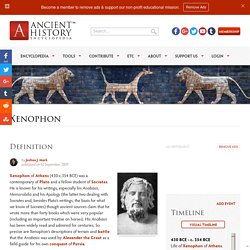
He is known for his writings, especially his Anabasis, Memorobilia and his Apology (the latter two dealing with Socrates and, besides Plato’s writings, the basis for what we know of Socrates) though ancient sources claim that he wrote more than forty books which were very popular (including an important treatise on horses). His Anabasis has been widely read and admired for centuries. So precise are Xenophon’s descriptions of terrain and battle that the Anabasis was used by Alexander the Great as a field guide for his own conquest of Persia. According to Diogenes Laertius (writing c. 200 CE), Bizans'ın Sanat Yıkımı: İkonoklast Dönem. Bizans İmparatorluğu’nun tarihinde büyük bir hasar yaratılmasına ön ayak olan İkonoklast dönem, yalnızca dini sebeplerce oluşmaktan çıkıp, siyasi ve sosyo-kültürel olarak da sebepleri olan bir dönemi yarattı.

Yaklaşık 120 yıllık bir dönemi kapsayan ve büyük tahribatlarla Bizans Tarihi’nin sanatsal gelişimini etkileyen İkonoklazma; kelime kökeni olarak ‘ikon’ sözcüğünden geliyor. Grekçe ‘eikon’ yani ‘imge’ sözcüğünden türeyen ikon ve yine Grekçe ‘klao’ yani ‘kırmak, yok etmek’ sözcüklerinin birleşmesiyle oluşuyor. İkon; Doğu Kilisesi’nde İsa, Meryem, Azizler, Havariler ve kutsal kitaptaki dini hikayelerin duvara ya da ahşaba, boyalarla yapılan sembolik tasvirlerine verilen isim. İkonun, Hristiyan dünyasında oldukça önemli bir yeri var. İlkçağ Yunan Kültüründe Şarap ve Üretimi. Constantinople, Church of Divine Wisdom. Constantinople (Κωνσταντινούπολις) or Byzantium (Βυζάντιον): Greek city on the Bosphorus, capital of the Byzantine Empire, modern İstanbul.
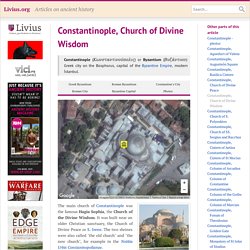
Use two fingers to move the map Map Data Imagery ©2016 CNES / Astrium, DigitalGlobe Map DataImagery ©2016 CNES / Astrium, DigitalGlobe. Hadrian's Rome - OpenLearn - Open University - A340_1. This free course, Hadrian’s Rome, explores the city of Rome during the reign of the emperor Hadrian (117–38 CE). What impact did the emperor have upon the appearance of the city? What types of structures were built and why? And how did the choices that Hadrian made relate to those of his predecessors, and also of his successors? Hadrian provides an interesting case study. 5 ancient sites of the Hittite Empire – HeritageDaily. Although the objects are not currently on display, a series of images will give the public a chance to see the Viking treasure for the first time, following a painstaking conservation project to remove and conserve the rare items, which date from 9th-10th centuries AD.
Credit : Historic Scotland The project is being funded by Historic Environment Scotland, working in partnership with the Treasure Trove Unit, and the Queen’s and Lord Treasurer’s Remembrancer (QLTR). The cache of objects were, until recently, contained in a ‘Carolingian’ (West European) vessel, or pot, which was part of a wider hoard, amounting to around a hundred items, which includes a large number of silver ingots and armrings, a beautifully-preserved cross, and an ornate gold pin in the likeness of a bird. Bugüne Kadar Keşfedilmiş Bilinen En Eski 7 Gıda. Gıdalar oldukça hızlı bozulduğundan, arkeologların asırlar geçse de günümüze kadar korunabilmiş gıdalar keşfetmesi büyük bir kutlamayı hak eder. İşte, bu kutlamayı hak eden, en eski ve saygıdeğer gıdaların 7’si karşınızda. 1.
Roma Şarabı. Palmira Antik Kenti'nin 150 Yıllık Fotoğrafları ve Eskizleri. Palmira Antik Kenti’nin 1867–1876 yılları arasında Fransız fotoğrafçı Félix Bonfils tarafından çekilen fotoğrafları tarihi kentin etkileyici atmosferini gözler önüne seriyor. Posthumous bust of Caesar (Illustration) The so-called Green Caesar, a posthumous bust showing Julius Caesar as a statesman dressed in a toga. Being idealised in contrast to earlier Caesar portraits, this portrait was adapted to the taste of the early Imperial Age. (Altes Museum, Berlin) About the Author Carole maintains the popular ancient history photo-blog Following Hadrian, where she travels the world in the footsteps of emperor Hadrian. Help us write more We're a small non-profit organisation run by a handful of volunteers.
Ancient Anatolian people. How Christianity came to Europe. During the Middle Ages nearly all the lands of Europe converted to Christianity. In this short guide, we take a look at how various lands adopted Christianity, including by means of missionary efforts, politics and warfare. Jesus healing the bleeding woman, Roman catacombs, 300-350 Early Christianity Starting with the first followers of Jesus Christ, Christianity spread out into the Middle East and along the Mediterranean Sea to other parts of the Roman Empire. Xia Dynasty. The Xia Dynasty (c. 2070-1600 BCE) was the first government to emerge in ancient China and became the first to adhere to the policy of dynastic succession; thus making it the first dynasty of China. It was regarded as a mythical construct of later Chinese historians until excavations in the late 20th century CE uncovered sites which corresponded to descriptions in these earlier historians' accounts.
The Xia were overthrown by the Shang Dynasty, a more historically certain governmental entity, who were in turn overthrown by the Zhou Dynasty. The argument claiming the Xia Dynasty is a mythological construct claims that the Zhou (and later dynasties) wanted to make clear that the previous ones lost their right to rule through immoral conduct and so created a proto-dynasty - the Xia - as a prehistoric model for this. Many scholars today still maintain that the Xia Dynasty is a myth but seem to be at a loss to explain why the physical evidence uncovered argues against their claim.
The Temple in Jerusalem. According to Jewish tradition, the original Jerusalem Temple was ordained by Yahweh/God, as described in 2 Samuel 7:12 where Yahweh commands Nathan to tell David: When your days are fulfilled and you lie down with your ancestors, I will raise up your offspring after you, who shall come forth from your body, and I will establish his kingdom. He shall build a house for my name, and I will establish the throne of his kingdom forever.
As well as the postexilic text, 1 Chronicles 28:2-7, where David declares: Beer. Beer is one of the oldest intoxicating beverages consumed by human beings. In the west, evidence of early beer brewing has been confirmed by finds at the Sumerian settlement of Godin Tepe in modern-day Iran going back to between 3500-3100 BCE. The Sumerians loved beer so much they ascribed the creation of it to the gods and beer plays a prominent role in many of the Sumerian myths, among them, Inanna and the God of Wisdom and The Epic of Gilgamesh. The Sumerian Hymn to Ninkasi (written down in 1800 BCE but presumed to be much older) is both a praise song to the goddess of beer and a recipe for brewing. Brewers were female, most likely priestesses of Ninkasi, and early on beer was brewed by women in the home as a supplement to meals. Mausoleum at Halicarnassus. Scale model of a reconstruction of the Mausoleum, one of many widely differing versions, at Miniatürk, Istanbul.
Sumerian Civilization: Inventing the Future. Imagine something that has never been thought of before. If one holds a book in one’s hands, one can imagine an e-book, a large-print book, a picture book, all kinds of books. But how does one imagine a book in a world where even the concept of a `book’ does not exist? Imagine a day without time. The Extent of the Roman Empire. The Extent of the Roman Empire. Ostrogoth. When the Roman Empire split, how did each side view one another? Were there border tensions? : AskHistorians. 10 Hidden Ancient Treasures in Caria, Turkey. Ancient Greek Temples of the Mediterranean. Zenobia. İSTANBUL’UN ANTİK TİYATROSU NEREDE? Picture of the day: The Temple of Apollo at Claros, Ionia.
Claros. Ionia. The Temple of Hadrian at Ephesus, Ionia (Turkey) The Hadrianic Baths at Aphrodisias, Caria (Turkey) Io, Saturnalia! Did the Romans Invent Christmas? Zoroaster. Cultural links between India and the Greco-Roman world. Han Dynasty. The Maccabean Revolt. Belisarius. The Ancient Theatre Archive. Telling Time in the Middle Ages: 5 Things You Didn’t Know. The Saxons. Hagia Sophia. Hagia Sophia. The ancient Vespasianus Titus Tunnel of Turkey. Migration Age. The Egyptian Amulet: Pious Symbols of Spiritual Life. The Legend of Sargon of Akkad. Lucius Quinctius Cincinnatus. 10 Hidden Ancient Treasures in Caria, Turkey. Pergamon. Group of videos about Justinian : byzantium. There’s method in the madness of Isis’s cultural vandalism - Comment - Voices - The Independent. What Caused the Mysterious Bronze Age Collapse? Fertile Crescent. True History. Palmyra: a stunning ancient city under threat from Isis – in pictures.
ELI5: How can Roman bridges be still standing after 2000 years, but my 10 year old concrete driveway is cracking? : explainlikeimfive. The Hadrianic Baths at Aphrodisias, Caria (Turkey) - Ancient History et cetera. The Hadrianic Baths at Aphrodisias, Caria (Turkey) - Ancient History et cetera. The Hadrianic Baths at Aphrodisias, Caria (Turkey) - Ancient History et cetera. The Hadrianic Baths at Aphrodisias, Caria (Turkey) - Ancient History et cetera. Palmyra. Uruk. Byzantine Medicine, Health and Healing.
The Enigmatic Poison King: Mithradates VI of Pontus (120-63 BCE) - Ancient History et cetera. The Gallic Wars by Julius Caesar. Perseus Digital Library. The Gallic War — Caesar. Greek Society (Article) Hand of a colossal statue of Constantine Ist the Great , Roman... News Photo. Armenia’s Conversion to Christianity (Article) Assassination of Julius Caesar. Turkish Archaeological News. Hercules. Hermes. Michelangelo’s Moses of the Julius Tomb: The Definitive Michelangelo Sculpture. Scythians. 7 Impressive Greek Bronze Statues - Ancient History et cetera. Sargon of Akkad.
The ancient Vespasianus Titus Tunnel of Turkey. Five Women Who Played a Role in Caesar’s Murder - Biography.com. Imperial cult (ancient Rome) Turkish Archaeological News. Battle of Pydna. Treasures Of The Lost Dhow - Ancient History et cetera. Confucianism. Peloponnesian War. Hadrian goes to Attaleia – images from Hadrian’s Gate at Antalya. Ancient History Encyclopedia. 40 maps that explain the Roman Empire. Roman Gods and Goddesses. Borsa Ä°stanbul'a ilham verdi - Genel.